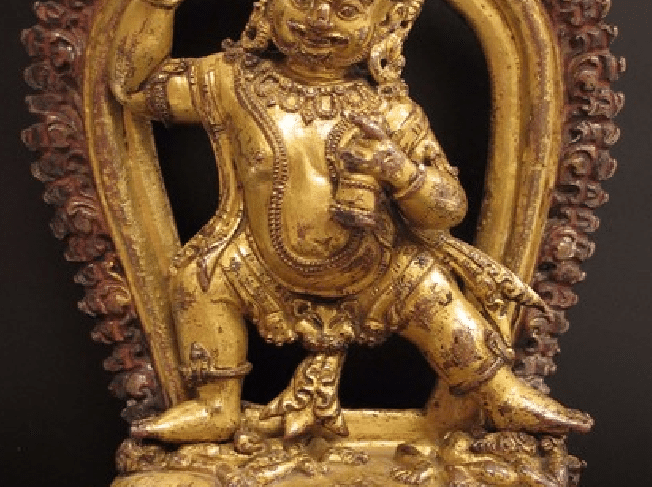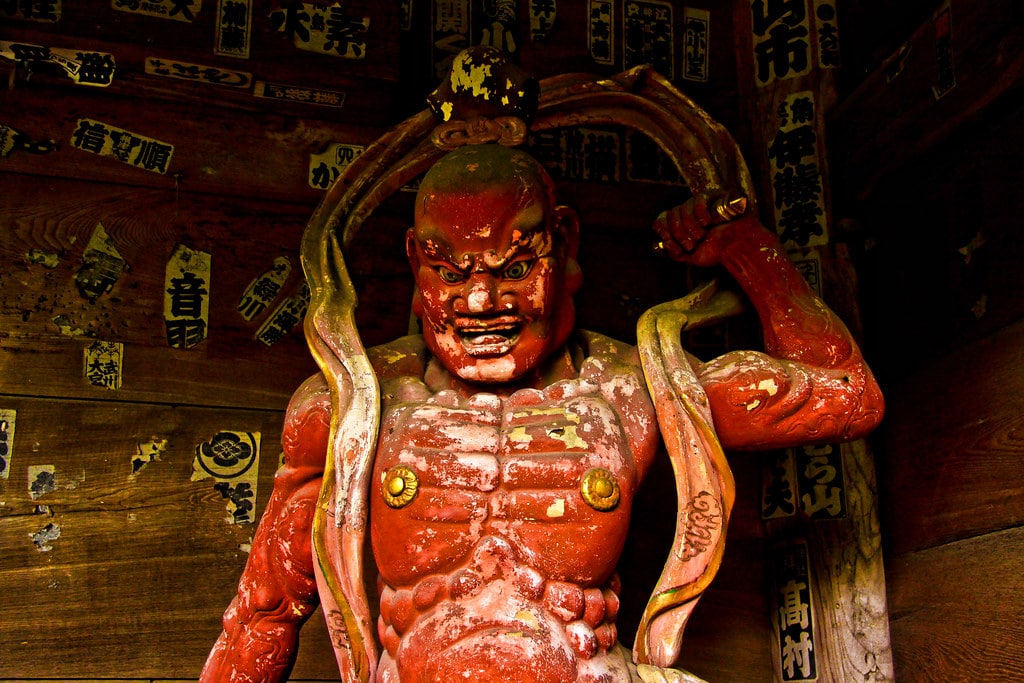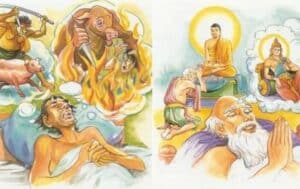The Vajrapani Bodhisattva mantra is a powerful tool in Vajrayana Buddhism, offering practitioners access to the immense energy and protection of this fierce but compassionate bodhisattva.
With its origins rooted in ancient Buddhist scriptures, the Vajrapani Bodhisattva mantra has been chanted by devoted practitioners for centuries, offering a pathway to enlightenment and overcoming obstacles on the spiritual path. Whether you are seeking inner strength and courage, protection from negative energies, or a connection with the powerful energy of Vajrapani, chanting this mantra can bring countless benefits to your spiritual practice.
Who is Vajrapani Bodhisattva?

Vajrapani Bodhisattva is a prominent figure in Mahayana Buddhism and is considered one of the eight great bodhisattvas. He is often depicted holding a vajra (thunderbolt) in his right hand and a lasso in his left hand. The name “Vajrapani” means “the one who holds the thunderbolt” in Sanskrit.
In Buddhism, Vajrapani is associated with power, courage, and determination, and is considered a protector and guide for practitioners on the path to enlightenment. He is also regarded as a manifestation of the Buddha’s compassion and wisdom.
In some Mahayana Buddhist texts, Vajrapani Bodhisattva is said to be the manifestation of a god who rules over the Trayastriṃsa region, and in Hinduism, he is known as the god of rain and is depicted in Gandharva images. According to legend, Vajrapani Bodhisattva is the god who aided Prince Siddhartha in escaping from the palace after he took his oath.
Buddhist researcher Xuanzang in China recorded that Vajradhara Bodhisattva defeated a large snake in Udyana. In another version of the story, it is said that when Naga, the great snake, came to hear the Buddha preach the Dharma, Vajrapani transformed Naga into a bird to deceive those who wanted to kill it. The origin of Bodhisattva Vajrapani also appears in the Pali scriptures as a Yaksha, a god who rules over an area and is feared by evils.
Vajrapani is believed to have played an important role in the Buddha’s teachings, particularly in the transmission of the Vajrayana or Tantric teachings. He is also associated with the practice of mantra recitation, which is a central practice in Vajrayana Buddhism.
In art, Vajrapani is often depicted with a wrathful expression, symbolizing his power to overcome obstacles and negativity. He is also sometimes depicted with a third eye on his forehead, symbolizing his insight and wisdom.
The Meaning of Vajrapani Bodhisattva mantra
The Vajrapani Bodhisattva mantra is a sacred sound formula used in Vajrayana or Tantric Buddhism to invoke the blessings and protection of Vajrapani Bodhisattva. The mantra is usually recited repeatedly as a form of meditation and spiritual practice.
The mantra is “Om Vajrapani Hum,” which is often translated as “Hail to the diamond-bearing one.” The word “vajra” in the mantra refers to the thunderbolt symbol that Vajrapani holds, which represents his ability to cut through obstacles and negativity.
Reciting the Vajrapani Bodhisattva mantra is believed to help practitioners develop inner strength, courage, and determination to overcome obstacles on the path to enlightenment. It is also said to help purify negative karma and protect from harm.
In addition to the “Om Vajrapani Hum” mantra, there are also other mantras associated with Vajra, such as the “Vajrasattva mantra” and the “Vajra Guru mantra“, which are commonly used in Vajrayana Buddhist practice.
The Benefits of chanting Vajrapani Bodhisattva mantra
The Vajrapani Bodhisattva mantra consists of his name “thunderbearer” framed between the sacred syllables Om and Hum. By reciting this mantra, practitioners can access the powerful energy that Vajrapani represents.
For meditators, Vajrapani is a means to fulfill their fierce determination to conquer the challenges and obstacles that often arise on the spiritual path.
Chanting the Vajrapani Bodhisattva mantra is believed to bring various benefits to practitioners in Vajrayana Buddhism, including:
- Overcoming obstacles: Vajrapani is often associated with the thunderbolt symbol, which represents his ability to cut through obstacles and negativity. Chanting the mantra is believed to help practitioners develop inner strength, courage, and determination to overcome obstacles on the path to enlightenment.
- Purifying negative karma: Chanting the Vajrapani Bodhisattva mantra is said to help purify negative karma and negative energy, leading to a more positive and peaceful state of mind.
- Protection: Vajrapani is considered a protector and guide for practitioners on the path to enlightenment. Chanting the mantra is believed to help protect against harm, negative influences, and negative energies.
- Developing inner strength and compassion: Vajrapani represents the union of compassion and strength. Chanting the mantra is believed to help practitioners cultivate these qualities within themselves, leading to greater inner strength, resilience, and compassion towards others.
- Connection with Vajrapani: Chanting the mantra is considered a way of establishing a spiritual connection with Vajrapani Bodhisattva, inviting his blessings and guidance on the path to enlightenment.
The Vajrapani Bodhisattva mantra consists of his name “thunderbearer” framed between the sacred syllables Om and Hum. By reciting this mantra, practitioners can access the powerful energy that Vajrapani represents.
For meditators, Vajrapani is a means to fulfill their fierce determination to conquer the challenges and obstacles that often arise on the spiritual path.
Anyone who follows the Buddha Dharma can be protected by Vajrapani Bodhisattva, whose mantra makes them invincible against any evils attacks or harassment. Regular recitation of this mantra can increase one’s merit, and relying on Vajradhara Bodhisattva like Shakyamuni Buddha used to. You will surely be protected from all obstacles
Chanting this mantra can cure diseases, bring good luck and success in work, and fulfill all wishes. The benefits of practicing this ritual are countless, and there is no obstacle to those who practice it.
To recite the mantra effectively, practitioners should find a quiet place to chant and enter into deep meditation. You should aim to reach a state of stillness where there is almost no awareness of their surroundings. At this level, chanting the mantra is most effective.
Overall, chanting the Vajrapani Bodhisattva mantra is considered a powerful spiritual practice in Vajrayana Buddhism, with the potential to bring numerous benefits to practitioners.







